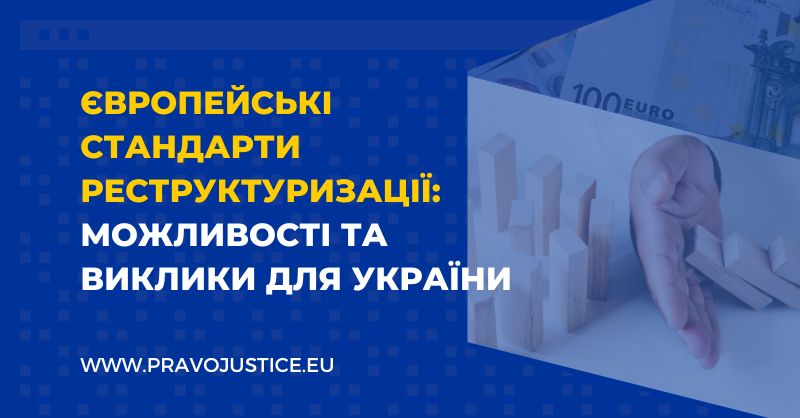European Restructuring Standards: Opportunities and Challenges for Ukraine

According to the Supreme Court, there were 9,725 bankruptcy proceedings opened in 2022, which is 42% less than in the same period in 2021 (16,791 proceedings respectively). At the same time, this does not mean that businesses in 2022 have fewer solvency problems than in 2021. It is clear that Russia’s war against Ukraine is the main factor behind a deterioration in business solvency, which in peacetime was highly profitable and competitive.
A significant number of bankruptcy cases in Ukraine end up with the liquidation of the debtor. Bankruptcy proceedings themselves are quite lengthy and involve high costs and significant indirect expenses. Financial restructuring is available to Ukrainian businesses, but only enterprises that owe money to banks can use it. With the exception of a few successful cases, pre-trial rehabilitation procedures for general (“non-bank”) debt have not become widespread.
On the other hand, functioning businesses facing temporary financial problems need a transparent and efficient debt restructuring mechanism to get a second chance. For example, these may be businesses that were located close to the frontline or in the de-occupied territories which temporarily suspended production cycles and supply chains but are able to reach pre-war performance levels and pay their partners within a reasonable timeframe.
As part of the Memorandum of Understanding with the EU on Macro-Financial Assistance in 2023, Ukraine has committed to improve its corporate bankruptcy procedures in line with the principles set out in EU Directive 2019/1023 on Preventive Restructuring (Directive). EU Project Pravo-Justice analyses the practice of implementing the Directive in European jurisdictions neighbouring Ukraine and develops a dialogue with the European community of leading insolvency practitioners.
Given how complex the Directive is, implementing it is a challenge for Ukraine, but on the other hand, it opens up opportunities for viable businesses that have experienced financial difficulties to get a second chance. The business community has experienced a situation where a functioning company is unable to pay off a creditor at a certain point in time, but it is likely to do so in the short term if the business survives. It is for such cases that preventive restructuring should work.
The main novelties that the Directive will bring to Ukrainian business are as follows. Introducing mechanisms for early insolvency detection, in particular, the state should create conditions under which the risk of insolvency will be detected at the initial stages. In certain cases, the restructuring procedure should be carried out with the mandatory involvement of a bankruptcy trustee to ensure that the interests of the debtor and its creditors are balanced.
In its restructuring plan, the debtor must substantiate why its business is viable and why the restructuring meets the best-interest-of-creditors test). In order to ensure that debtors do not abuse preventive restructuring, enforcement actions may be suspended for a period not exceeding 12 months, rather than the current practice of suspending them for the entire duration of the pre-trial rehabilitation procedure. The state should create conditions under which the financing provided in the restructuring procedure and related transactions will be protected from invalidation or other challenges. Similarly, conditions should be created to protect against possible legal responsibility for those providing such financing to the debtor.
EU Project Pravo-Justice hopes that implementation of the principles set out in the Directive into national legislation will have a positive impact and provide functioning companies an extra chance to regain solvency, save business and jobs. For its part, EU Project Pravo-Justice will continue sharing its experience and is ready to provide expert support to state institutions on the path of aligning bankruptcy legislation with EU standards.
The text was first published in the blog of the EU Project Pravo-Justice on LB.ua